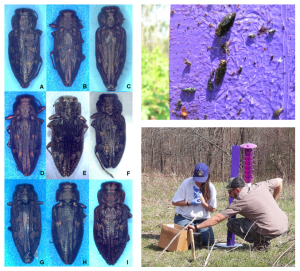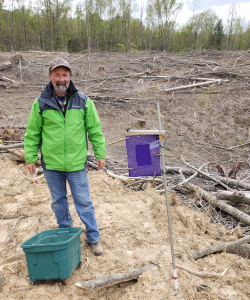Identification, Monitoring/Trapping & Management of Flatheaded Borer Beetles
 Flatheaded borer beetles in the genus Chrysobothris can cause considerable damage to the trunk and stems of woody ornamental plant species. Young trees and liners being grown as commercial nursery stock may be compromised during crop production. Established trees in managed landscapes and the urban forest can become infested when neglected or subjected to biotic and abiotic stressors.
Flatheaded borer beetles in the genus Chrysobothris can cause considerable damage to the trunk and stems of woody ornamental plant species. Young trees and liners being grown as commercial nursery stock may be compromised during crop production. Established trees in managed landscapes and the urban forest can become infested when neglected or subjected to biotic and abiotic stressors.
 We are building upon past research projects with the goal of developing improved methods for trapping Chrysobothris species. Ongoing work will use past specimen collections, museum and loaned privately-collected specimens to build molecular diagnostic capabilities using next-generation sequencing. Assembled genomes will be screened to identify diagnostically informative genes that can discriminate between species in the Chrysobothris femorata species group and assist in identifying larvae to species.
We are building upon past research projects with the goal of developing improved methods for trapping Chrysobothris species. Ongoing work will use past specimen collections, museum and loaned privately-collected specimens to build molecular diagnostic capabilities using next-generation sequencing. Assembled genomes will be screened to identify diagnostically informative genes that can discriminate between species in the Chrysobothris femorata species group and assist in identifying larvae to species.
Host-Pathogen-Vector Interactions: TCD

Thousand Cankers Disease Host-Pathogen-Vector Complex. (Daniels et al. (2016) Forests, 7:260.)
Geosmithia morbida is the fungal pathogen that causes Thousand Cankers Disease (TCD) when spread within and between susceptible host plant species by the walnut twig beetle vector, Pityophthorus juglandis. In TN, other bark and ambrosia beetles are associated with G. morbida (and other Geosmithia species) in infested habitats.
Research projects include regional assessment of walnut tree decline and potential recovery from TCD in eastern TN; trapping optimization studies for P. juglandis monitoring; molecular detection and multiplexing to assay for G. morbida and P. juglandis DNA from suspected host plant tissues; and interactions of potential biological control fungi (Cordyceps, Beauveria, Trichoderma) within infected host trees.
The complex co-evolutionary history of G. morbida, with its primary host has also enabled use of this host-pathogen-vector complex as a model for identifying and assessing candidate genes and functions required for pathogenesis.
Host-Pathogen-Vector Interactions:
Laurel & Oak Wilt Diseases

Oak Wilt fungal mat on red oak and sap beetles associated with the host-pathogen-vector complex. (Photos courtesy of Demian Gomez; NYS Dept. Envir. Conserv. Forest Health Diagnositic Lab)
Research projects have included sampling and evaluations of sassafras trees infected with Laurel Wilt in middle and eastern TN; sampling host tree tissues and bark and ambrosia beetle association with the Laurel Wilt pathogen (including X. glabratus) in eastern TN; and development of molecular DNA detection assays for Harringtonia (syn. Raffaelea) lauricola from candidate vectors and host plant tissues.
Oak wilt disease efforts include field sampling of sap beetles with Texas collaborators; novel molecular diagnostics and detection assays for Bretziella fagacearum DNA from suspected host plant tissues, and candidate vector sap beetles (Nitidulidae) collected in forested and landscape habitats.
Collaborative Projects
Conservation, Population Genetics, and Biodiversity

Ruth’s Golden Aster (Pityopsis ruthii), an endangered Tennessee endemic (Credit: Naalamle-Amissa)
Past and ongoing collaborative projects include research and surveys of:
- pollinators and floral visitors to threatened Ruth’s Golden Aster and
- propagation, growth, and re-introduction of regionally threatened wood lily (Lilium philadelphicum)
Population Genetics: Host Plants, Pathogens & Native Species
We are working with collaborators to study genetic variation and patterns of gene flow within selected tree and fungal species across their introduced distributions (G. morbida, P. juglandis, Pyrus calleryana) or native ranges (Cercis canadensis, J. nigra, P. ruthii, etc.). Studies will detail the influences of spatial fragmentation, host-pathogen interactions, and host-pathogen co-evolution to elucidate the ecological and evolutionary history of genetic variability within species as a response to plant disease outbreaks, invasive plant spread, and human-mediated dispersal.
Phytobiomes of Trees
Plant phytobiomes consist of a plant, its associated microbial communities, and the environment, all of which are integral to understanding plant-stimuli responses. With collaborators, we are investigating:
- host-pathogen-vector interactions of the Thousand Cankers Disease Complex (TCD) as a medium to examine host plant phytobiomes and their effects on disease severity in walnut (Juglans) species.
- Influence of prescribed fire on phytobiomes in flowering dogwood (Cornus florida)

